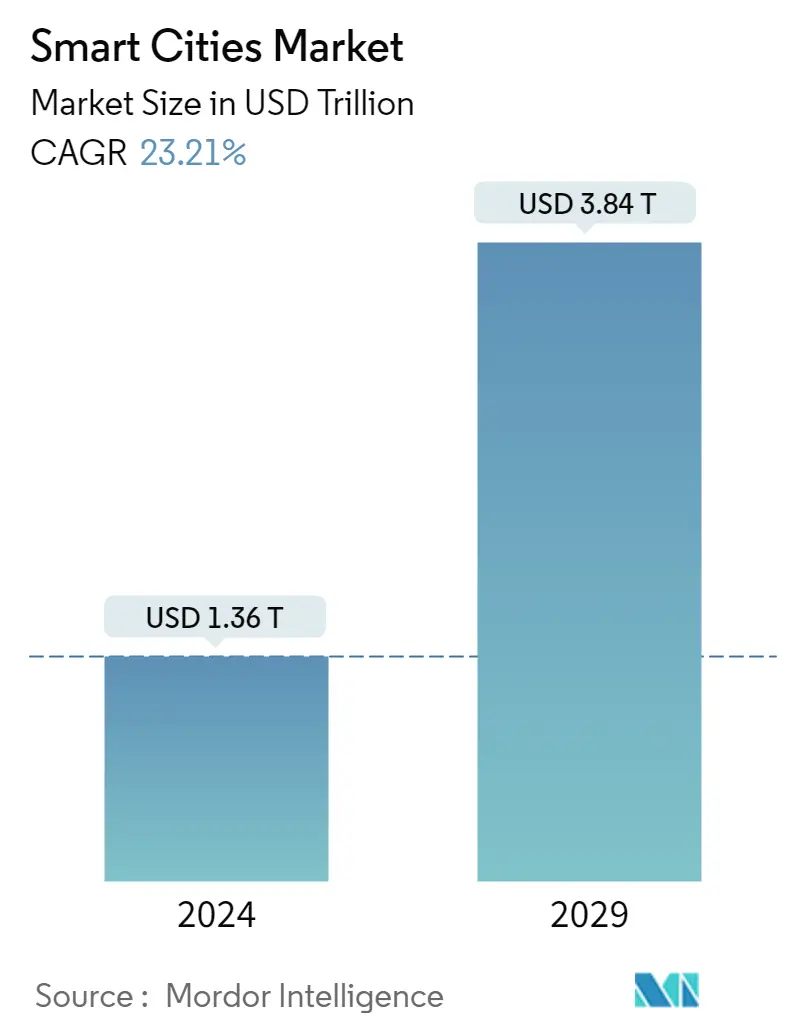Market Size of Smart Cities Industry

| Study Period | 2019 - 2029 |
| Market Size (2024) | USD 1.36 Trillion |
| Market Size (2029) | USD 3.84 Trillion |
| CAGR (2024 - 2029) | 23.21 % |
| Fastest Growing Market | Asia-Pacific |
| Largest Market | Europe |
Major Players
*Disclaimer: Major Players sorted in no particular order |
Need a report that reflects how COVID-19 has impacted this market and its growth?
Smart Cities Market Analysis
The Smart Cities Market size is estimated at USD 1.36 trillion in 2024, and is expected to reach USD 3.84 trillion by 2029, growing at a CAGR of 23.21% during the forecast period (2024-2029).
The market numbers in the study indicate the revenue generated from various types of solutions such as smart mobility management, smart public safety, smart healthcare, smart building, smart utilities, smart security, smart education, and other solutions.
- A smart city is an urban area that makes use of cutting-edge technologies such as artificial intelligence (AI), the Internet of Things (IoT), cloud storage, big data, and data analytics to gather and analyze utilization data and use the insights gained from them to manage resources, services, and assets effectively. Growing government measures to address urbanization and overpopulation and the growing need for resource management for sustainable development are driving growth in the smart cities industry.
- The increased adoption of the Internet and the Internet of Things propel the growth of smart cities and platforms worldwide. It is expected that by the next three years, there will be more than 26 smart cities, with the majority existing in North America and Europe, providing a major drive to the AI and IoT sensors for adoption in smart cities.
- From the first telegraphic fire alarms to radios and dash cams, public safety agencies-law enforcement, fire, EMS, and emergency management-have always been early adopters of the newest technologies. Increasing smart device networks and the development of artificial intelligence are turning public safety technology today from a necessary toolkit into an independent partner that can take action to keep the public safe.
- Various organizations in the studied market are focusing on strategic partnerships, investments, and expansion to help countries adopt smart solutions. For instance, in October 2022, Nokia announced a strategic partnership with Nedaa, the security network provider of the Dubai government, to explore innovative 5G network slicing for public safety use and smart cities. Similarly, in October 2022, Siemens AG announced to invest EUR 5 billion ( USD 5.41 billion) in India to support the country's rapid urbanization and energy transformation.
- Moreover, in February 2023, Companies from Singapore and Asia Pacific, such as Daily Life Renewable Energy, Mdesigns Solutions, Biodsg, and Graymatics, among others, will collaborate with United Arab Emirates (UAE) firms to develop smart city pilot projects in Abu Dhabi. These companies will collaborate with local entities such as Adnoc and the rest to develop resilient cities by transforming street lighting and increasing the energy efficiency of Al Dannah City buildings.
- Data security is the prime concern of every government incorporating the smart city plan, as it is vital in industries such as BFSI, retail, healthcare, and others, owing to the sensitive nature of the data. IoT platforms used for smart cities are experiencing high adoption rates due to IoT demand. This increasing use of these platforms for smart cities across various verticals has increased the vulnerabilities of these systems to data breaches. The need for a uniform security platform is increasing, with many providers offering multiple solutions.
- COVID-19 propelled the development of smart cities. Smart city infrastructure helped government agencies avoid the dangerous COVID-19 virus. Post-COVID-19, the government has also been investigating the potential for implementing some smart city technologies to increase urban resilience in times of crisis. The government of Singapore has acknowledged the significance of accelerating the nation's degree of digitization across industries.
